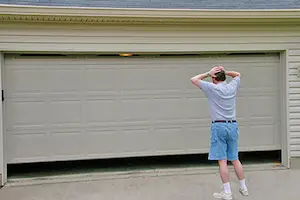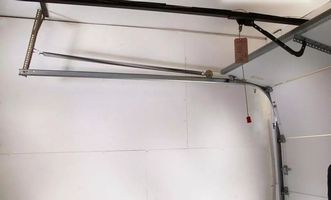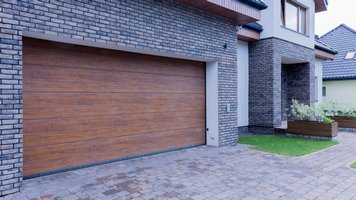Different Types of Garage Doors (Options, Styles and Cost)
This post contains affiliate links.
Garage doors are usually the first thing people notice when pulling into your driveway. This means you want to choose the right garage doors for your needs. However, there are so many options to choose from it cannot be easy. What are the different types of garage doors?
Garage doors can be divided into types, configurations, materials, or styles. It may make sense to start with types, then configurations, materials, and styles. You may also want to factor cost and maintenance into your decision.
In this ultimate guide, we will look at all the garage door types. We also look at the possible combinations you can build your door on. We also try to answer some common questions people have about garage doors.
| Garage Door Options | Examples |
| Types | -Sectional. -Roll-up. -Tilt-up. -Tilt-up Retractable. -Swing Out. -Slide to Side. -Bifold. |
| Configuration | -Double Wide Door. -Single Bay Door. -Double Wide + Single Bay. |
| Materials | -Steel. -Wood. -Composite. -Wood Composite. -Vinyl/Fiberglass. -Aluminum. |
| Styles | -Contemporary. -Craftsman/Carriage. -Traditional/Classic. |
Garage Door Types
Types refer to the kind and how the garage door operates. You can choose between the classic sectional door or go all fancy and pick up a tilt-up retractable door.
Sectional Garage Doors
Sectional garage doors may be the most common type in the United States. The doors are usually made from steel and are low in maintenance.
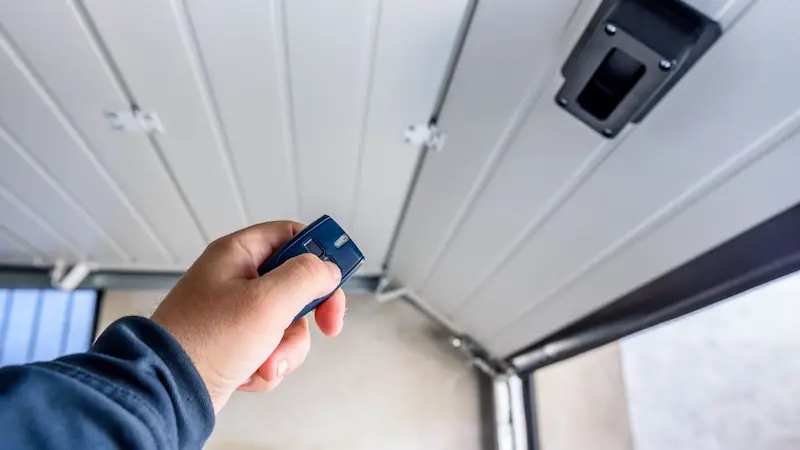
Sectional garage doors are much more customized too. They may have window inserts, hardware, textures, colors, and ventilation grilles. These doors come in both insulated and non-insulated models.
A sectional garage door panel is divided into sections, which are held together by hinges. When you open and close the doors, the wheels at the bottom edge of the panels roll at their vertical track sides.
The hinges help the garage door panel to bend, affecting its opening. This feature also allows the door to parallel the ceiling or floor.
A pair of high-tension springs are usually at the top of the opening. It connects to wires that operate the door and holds it from falling when only partially open.
Roll-Up Garage Doors
The roll-up garage doors are the strongest of all types. You may see them in commercial and industrial or storage places. These days, they are now making their way into residential garages.
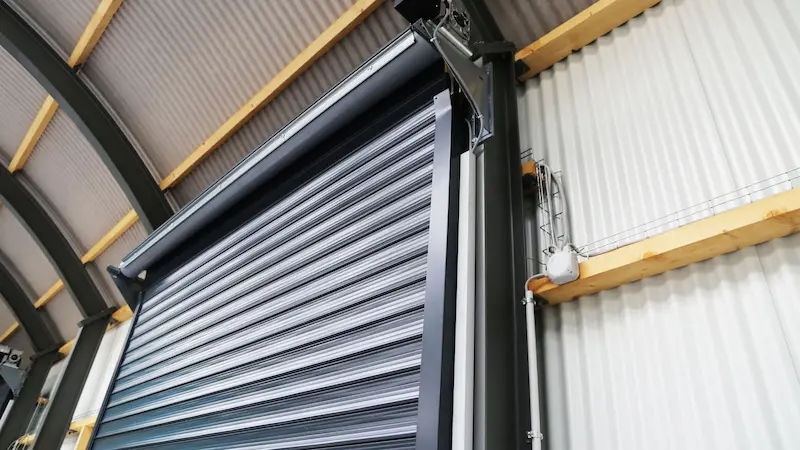
When you open a roll-up garage door, it starts rolling around a cylinder. The cylinder is above the garage door opening inside the garage.
The door can do this because it consists of horizontal 2″-3″ steel or aluminum slats. This makes the door able to curve and bend.
They occupy little vertical space when opened. You can also create lofts and storage space along with the ceiling.
Tilt-Up Garage Doors
Unlike slide-to-the-side and roll-up garage doors, tilt-up garage doors do not have sections. They are made of one solid piece. When they open, these doors tilt up and into your garage.
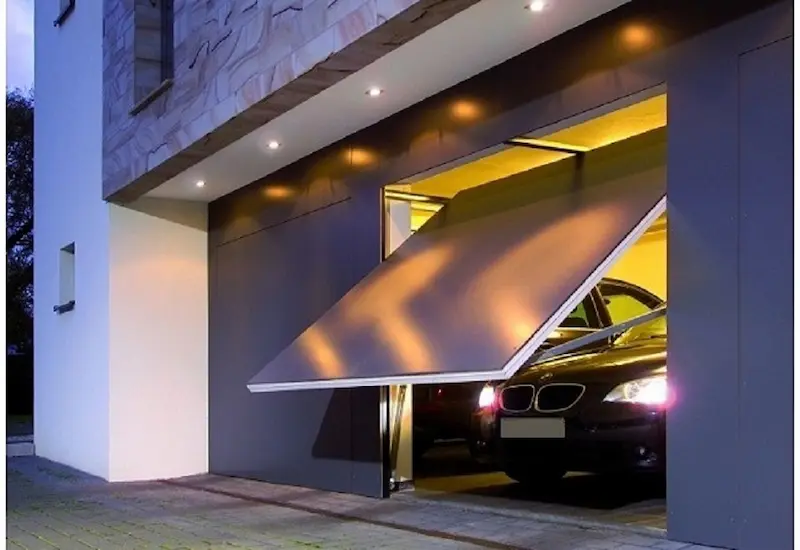
When opened, the door panel sits parallel to the garage ceiling. It also extends somewhat past the house’s front when the door is open.
Tilt-Up Retractable Doors
This is a variation of tilt-up garage doors. It works likewise to a canopy garage door, but no part of the garage door extends from your home when it’s open.
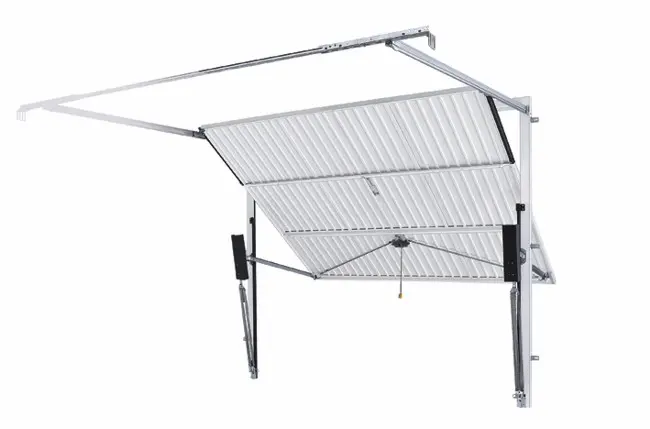
They are suspended separately from the frame. This configuration requires more space than regular tilt-up garage doors. They are also more challenging to operate and are more expensive.
Swing-Out Garage Doors
Another classic garage door style is the side-hinged garage door. Some may also call it the swing-out garage door. These look very traditional and are easy to operate.
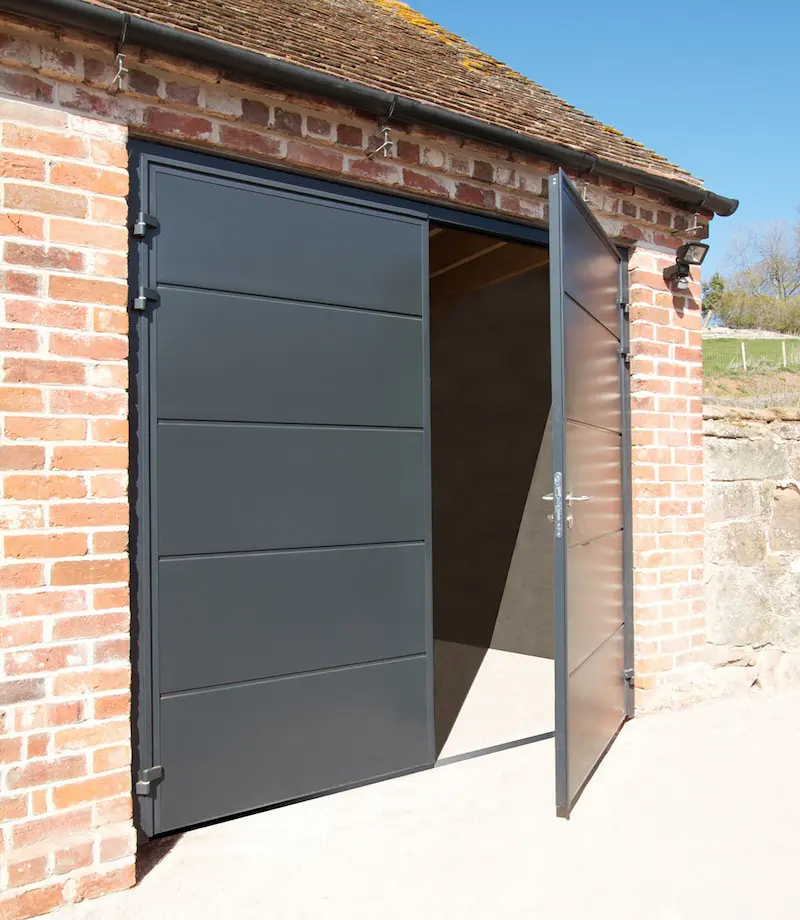
They are mostly swing-out types but can also have a faux design that looks like carriage doors but go up and down. More industrial-type galvanized steel doors are also available.
Classic doors like these are popular with garages with limited headroom and space. Side-hinged garage doors usually come with pre-hung steel frames. Some can also fit into existing openings.
You can adjust the hinges to swing the door panel inwards or outwards. Swinging outwards is the common choice since they do not alter the space inside the garage. They can also be automated with special openers.
Slide-to-Side Garage Doors
The slide-to-the-side garage door operates exactly as the name implies. You slide the door to the side or around the corner. It is one of the earliest ways of operating a garage door.
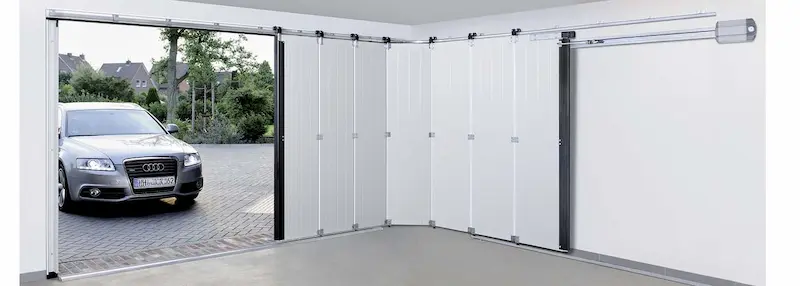
They run along with lower trolleys. These trolleys are also flexible enough to work, even if there are some slopes on the floor or ceiling.
Slide-to-the-side doors do not need springs and can have a retractable motor for automated operation. The track length is about twice the door width.
Bifold Garage Doors
Bifold garage doors function like closet doors. On every side of the door, you have hinged vertical sections that fold back against the sides of the opening. It is usually manually operated, although you can install motors to automate it.
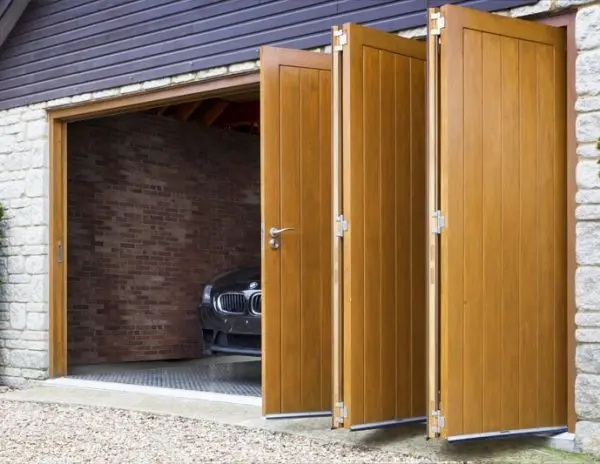
Bifold doors aren’t as heavy as swing-out doors and don’t open out as far. This makes them a good choice with small garages.
However, snow or mud buildup could still block them from working. It can’t be sealed as tightly as swing-out or sectional doors.
Garage Door Configuration
The garage door comes in two configurations, single bay or double wide. Your choice may depend on the size of your garage or how many cars you plan to park inside.
Single Bay Doors
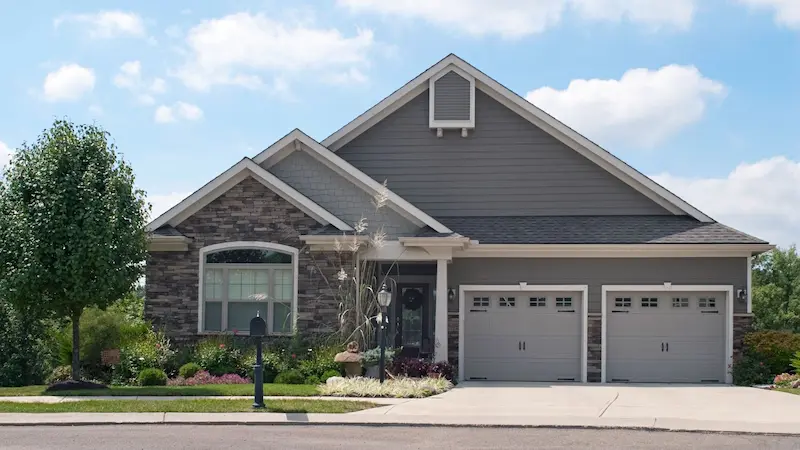
Single bay doors are wide enough to accommodate a single car. Common ones are around 8 to 9 feet wide.
As a result, single-bay doors may be popular with smaller garages. Some larger garages also may have multiple single bay doors.
Double Wide Door
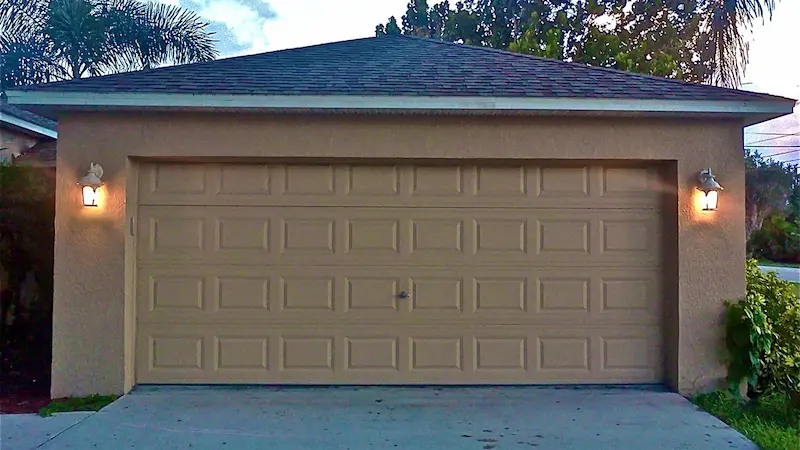
A double-wide door may work if you have a larger garage and want a larger opening to access it. It is called a ‘double’ because it can handle two cars through it.
The common double-wide door is about 16 feet wide. Some may also get a wide double door for aesthetics since it does look better than two single bay doors.
Double Wide And Single Bay
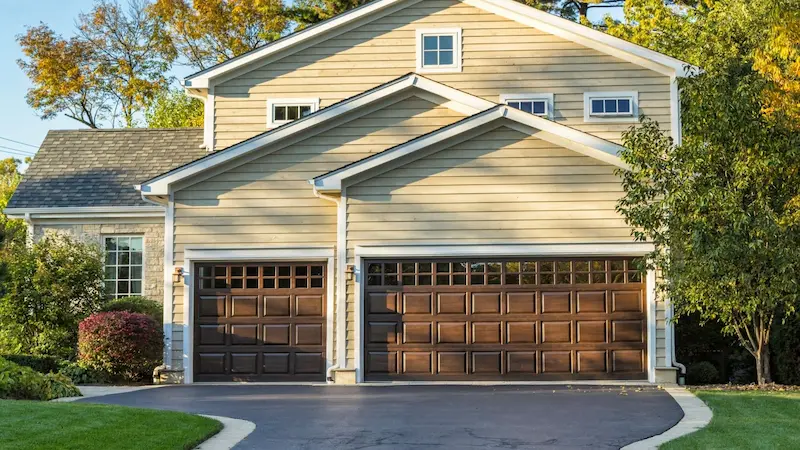
Another possible combination you can consider is to have both in your garage door.
This may be an option if your garage is large enough. Some garages may be too large for a single, double-wide door, yet not large enough to have two double-wide doors. You can also have double-wide doors on the front and a single bay at the back or side of your garage.
Read more about different types of garages here and garage sizes here.
Garage Door Materials
You can use many types of materials for your garage doors. Common ones include wood and steel. However, lightweight materials such as aluminum and vinyl are becoming more popular.
Steel Garage Doors
Steel garage doors are the most popular. They are practically maintenance-free, durable, and have the lowest cost. Common steel garage doors may cost you around $500 to $3,200.
They are often available in many colors and styles. They also have many window options and are available with many insulation options. Most garage doors sold nowadays are made of steel.
These tough doors are inexpensive. You do not have to worry about steel doors requiring significant repairs, nor do you worry about damages. These are tough doors and should handle abuses you can throw at them.
One downside of steel doors is that they can dent if hit, so you must be careful when playing sports in the driveway. If you scratch the door, ensure you coat it quickly.
Exposed metal parts are basically rust magnets. You want to avoid that from happening to your door.
One way to reduce rusting is to choose a steel panel with a lower gauge. With gauges, the bigger the number, the thinner the steel gets.
Get doors with at least 24-gauge steel. Many lower-priced garage doors are made from 25-gauge or thinner steel. Thin doors do not last as long, and they dent easily too.
You can also get a steel door that comes with an overlay. Overlays are usually made of fiberglass. They are more rigid and do not rust, unlike steel. However, they fade more quicker under the sun than steel.
Make sure you spend time and understand about warranties offered on the door. This is because some manufacturers will provide lifetime warranties on certain components.
Wood Garage Doors
Wood garage doors are also one of the most common materials. It also offers the widest selection of styles, shapes, and decorative add-ons. As a result, the price can vary a lot, from $1,000 to over $5,500.
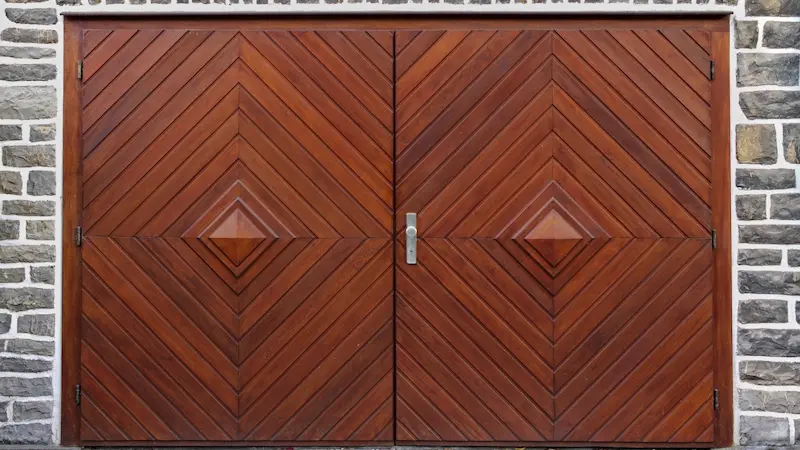
Real wood doors look excellent when they’re new. But they may damage, fade or crack unless you devote time and money to maintain them. Wood garage doors are for those who want to make a statement.
Wood garage doors are sometimes made from exotic woods like hemlock and mahogany. Wood garage doors are perfect for high-end homes with stone or stucco facades.
Wooden garage doors are incredibly popular and for good reasons. There is a certain beauty that wood doors have that other door types cannot replicate. This makes them a great choice for any home style.
Wood is also easier to shape and customize, making it easy to have them made to the exact size you need. This makes wooden garage doors popular with custom-sized garage doors.
Another good thing about them is their sturdiness. Unlike steel, they should stand up well to blunt impact and not dent.
The major problem with wood doors is maintenance. If you want to ensure they stay as new, you will need to refinish or repaint them regularly. If not, they will begin to chip and peel.
They also vary in price since they are very customizable. For example, you can make your frame and door panel completely from solid wood. If you want it cheaper, you can use thinner wood with insulation inside.
Composite Garage Door
If you prefer something less conventional, check out cellulose. Cellulose is man-made fibers fused with resins to create a material. A composite garage door may cost you between $450 to $4,000.
Composite materials do not crack, warp, or rot like wood. It definitely will not rust or dent, unlike steel. It is also low maintenance and can survive long exposure to the sun.
Each section of composite panels usually has a foam core for stiffness and insulation. Since it is a synthetic material, some people try to customize the look of the panels.
One of the more common ways is to paint the panels to look like wood. These are called composite wood panels and can be quite popular with many. They are definitely much cheaper than solid wood garage doors.
Vinyl/Fiberglass Garage Doors
Another popular option is to build your garage doors using vinyl or fiberglass. These are very sturdy materials and can last for a long time. One of these doors should cost you around $700 to $3,000.
Vinyl is a relatively new material used in garage doors but is gaining popularity, perhaps due to its hardiness and ability to give sound and heat/cold insulation.
Vinyl or fiberglass doors also do not rust, unlike steel. You definitely do not need to spend too much time painting or finishing the wood panels.
One issue with fiberglass doors is temperature. It may love the sun, but it may crack when under very cold temperatures. If you live in places with colder climates, you want to take note of this.
Full View Aluminum Garage Doors
If you want the durability and look of a steel door yet still want to keep it light, check out aluminum doors. Full-view aluminum doors are a little higher-end and look great on a modern-style home.
They are trending now, and the number of options is increasing. Many homeowners like to have aluminum garage door frames with glass panels.
These glasses could be tinted and frosted to create a premium and luxurious feel. The glasses used are not regular but tempered or impact-resistant glass.
Aluminum garage doors are, however, expensive. This is since aluminum itself is not a cheap material. Expect around $1,000 to $5,000 to have one made for your garage.
Garage Door Styles
Garage door styles look at the design or the look and feel of the door. You usually choose between modern or more traditional designs depending on your preference.
The overarching concept here is to match your garage door to the architecture of your home.
Contemporary
A contemporary garage door will add much visual interest to your home. It is a perfect design when your home’s exterior is more modern.
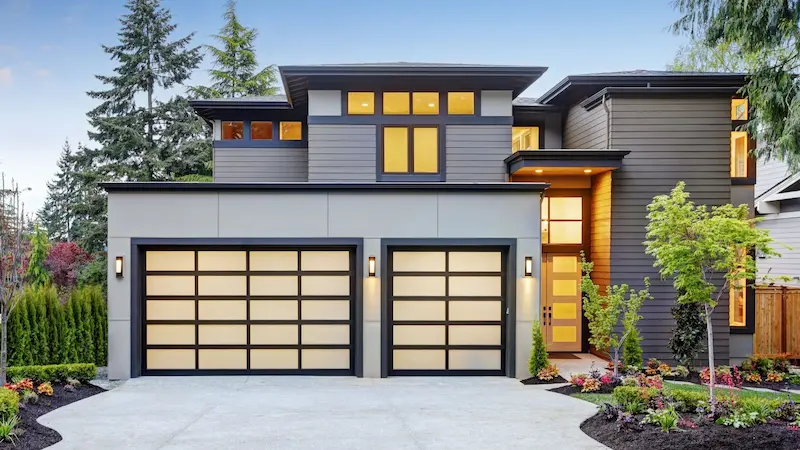
You can find a lot of information about these doors. Contemporary door designs add visual attention to your home and help to differentiate it. It may be easier for your friends to find your home too.
A contemporary door will also improve the curb appeal. Since it is a rather conservative design, it is also a safe bet.
If you want a contemporary garage door style, look for designs with windows, straight lines, and bold color choices. This will make the door stand out from the rest of your home.
Craftsman/Carriage
Carriage house garage doors are also known as “barn-style garage doors.” It has a distinctive, rustic look that can stand out well. It is also the perfect complement to craftsman-style or mission-style homes.
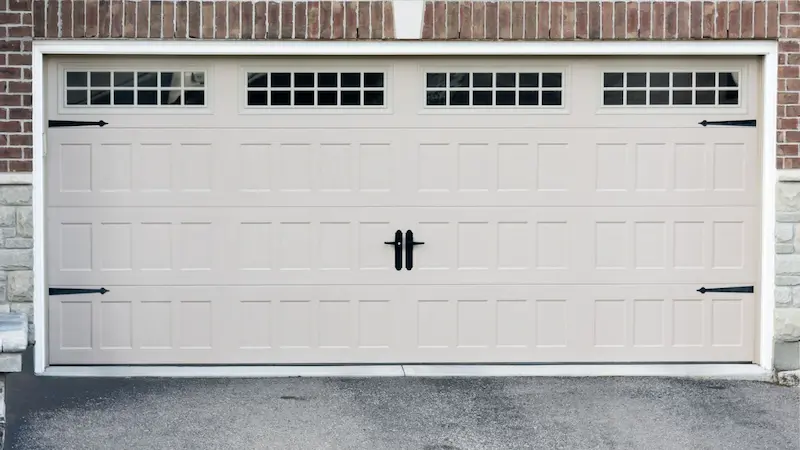
When picking a design, look for details that will set your door apart and reflect the style you like. Focus on handles, faux hinges on the side, and even cross beams across the door.
These doors are beautiful looking yet functional as their modern or traditional counterparts. They are also great for adding visual interest to your home.
Traditional/Classic
These garage doors have symmetrical, raised rectangular panels. Consider a traditional door for a timeless look and feel at your home.
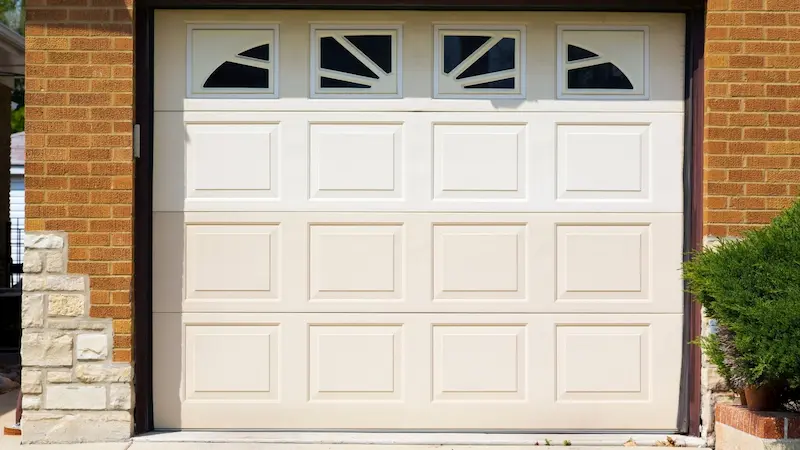
Traditional garage door styling is still popular for a good reason. They look great and have a timeless feel. They also vastly improve any home’s appearance.
Classic designs are safe bets when it comes to garage doors. It also has an understated feel. If you pick this design, you will not worry about your door overpowering the appearance of your home.
Tips When Choosing Garage Doors
When choosing garage doors, consider the following tips:
- Check out manufacturer’s websites when designing
- See if your garage door needs windows.
- Figure out your side doors.
- Consider upgrading insulation
- Check your garage door springs.
- Decide if you want to DIY
Check Out Manufacturer’s Websites When Designing Doors
When looking for garage doors, reduce guessing as much as possible. You do not want to guess, only to feel disappointed that your door does not look how you want it.
Many garage door manufacturers have software on their websites. You can use them to design your garage door.
Usually, you start by choosing a door style, including the design features you like. Then you pick windows, color, and add customization such as windows.
You can see a rendered version of your design. Feel free to play around with different ideas until you find a design you want.
Finally, print out the specs, and have the maker and installer give you a price quote. This way, you are assured that you will get exactly what you want.
Does Your Garage Door Need Windows?
A garage door usually looks much better with windows. This means you should at least consider if you want one for your door.
Beyond adding style, garage windows can also supply light to the garage interior. Consider these tips when picking up glass for your windows:
- If your garage has heating, upgrade to insulated glass.
- For extra privacy and security, install safety glass and or use frosted glass.
- Whenever possible, match the glass style to your house windows.
When shopping, decide if you want a door that will blend in with the rest of your home, or that will make a statement.
Also, consider the ambiance of the neighborhood. Will your garage door stand out like a sore thumb and cause your neighbors to complain?
Would you prefer a door that has windows or a solid door panel? Take the time to consider all your options to ensure you get a door you will be happy with.
Read More: Garage windows
Consider Side Doors for Attached Garages
Suppose your garage is attached to your home. Side doors are convenient as they allow you to go in and out of your garage without going outside.
This is a quicker way to access your garage and keeps you comfortable when it’s cold or raining outside.
However, a side door could also serve as an extra entry point to robbers if they break into your garage. This means if you have a side door between your home and garage, ensure it is secure and remains locked when not in use.
Consider Side Doors for Detached Garages
Suppose you use your garage to park your car. In this case, having a side door on your detached garage may not be a big priority.
But if you frequently access your garage for other reasons, such as using it as a workshop or storage. In that case, a side door can add many conveniences.
Opening a regular side door is quicker and easier than a larger garage door. If you need to go in and out often, you must shut the door behind you each time. This may be time-consuming with your main garage door.
Again, a side door installed in your detached garage must be as secure as your primary garage door.
Read More: Side Doors for Garages
Upgrade Your Garage Insulation
Depending on your location, an insulated and heated or cooled garage may be vital. An insulated garage helps keep everything in your garage at a steady temperature.
If you live in places with cold climates, this is important. You don’t want the inside of their garage to drop below freezing. Nobody likes their things inside to be frozen over, such as their valuables or car.
Even if you insulate your garage, much cold air can leak through the door. Opt for an insulated door to prevent items in your garage from freezing or being damaged in the cold.
An insulated garage is also something to think about if you have pets that sleep in the garage. This is because you will want to keep them as warm as possible. An insulated garage will also save you electricity bills.
Besides, suppose your garage is attached to your home, especially near a bedroom. In that case, you will want to opt for an insulated door. They will do much better to keep some cold air and street noise out of your home.
Read More: Insulating the Garage
Better Garage Door Springs
Garage door springs help your garage door go up and down. Most garage doors use torsion springs, although there are also extension springs.
You can see these coiled garage door springs above the door. Standard torsion and extension springs usually can last for about 10,000 cycles.
That may sound like a lot. But if you open and close your door six times daily, you’ll reach 10,000 cycles in less than five years. Opening and closing your garage doors six times a day is not much.
Spending an extra $50 when you shop for garage door springs will buy you a spring rated for 20,000 cycles.
Read More: Garage Door Springs
DIY May Not Be A Good Idea
You could save a few hundred dollars by installing the door yourself. However, this may be one DIY project that doesn’t have a big payoff.
For starters, there are many parts, and it’ll take you at least a full day to put them together. Plus, winding the spring needs special tools and lots of arm strength and is dangerous.
Suppose you hire an expert to install the door. In this case, the new door will be delivered, and the old one hauled away, and the work will be done in hours. (typical time is 3-6 hours). You also will have a warranty.
Final installation time may depend on things such as door size, required modifications, compatibility, and if custom wiring is needed.
FAQ
Can You Install New Garage Doors on Older Tracks?
Usually no. New garage doors are not compatible with the old tracks. Reusing old tracks is dangerous and also may void the warranty. The door could jam or derail, and springs could break.
New garage doors typically come with compatible tracks. Some may be adjusted for different tracks. If possible, use new tracks that fit well with the new doors.
Can You Paint Garage Doors?
You can paint garage doors, regardless of the material. You can paint over aluminum, metal, or wooden garage doors.
However, ensure you use the right primer and paint for the job. You also want to do the painting work when the temperature is moderate and the air is dry.
Avoid painting when the outdoors is damp from rainfall. Also, avoid painting when the temperature is too hot or too cold. These conditions can impact the paint’s potential to dry, which would be bad for the finish.
Suppose you want a custom color or want to renew a faded factory finish. In that case, you can apply two coats of acrylic latex over any door material, including fiberglass and vinyl.
Then sand and reapply the same type of paint every few years to keep the appearance fresh.
Read More: Painting the Garage Door
How Much Are Wooden Garage Doors?
You may wonder about the price of wooden garage doors since they vary in design, wood types, and customization.
Wooden garage doors range from $1,000 to $10,000 or more. On the lower end, you’ll find the pre-made plain varieties. You’ll find customized carriage doors with intricate designs on the high end.
Pre-made ( $1,000-$7,500): These are predesigned and pre-constructed from various tree species. They are also ready to ship and install right away.
Custom – $5,000-$10,000+: These are usually customized solid wood designs. The wood used is usually premium, such as cedar, redwood, hemlock, or mahogany.
Faux or Composite: $1,000-$8,000+: You can find faux wood and composite laminates over steel in a wide range of styles. Higher-end varieties use real wood veneers over insulated cores with 3 to 4 layers.
Are Garage Doors Sizes Standardized?
Manufacturers usually sell garage doors in widths from 8 to 20 feet. Older garage doors tend to use 8 feet wide doors. More recent designs would use 9 feet wide doors. For a double-door garage, 16 feet is the most common width.
As for the height, 7 or 8 feet is the normal range. This height applies to both single and double-door garages.
Are Insulated Garage Doors Worth the Money?
Garage doors usually come insulated or uninsulated. Insulated ones are the more expensive option. However, you can insulate garage doors yourself with insulation kits.
Insulated garage doors are only worth the money if you have an insulated garage wall. You also need proper sealing around the door. This is because if you insulate the door but leave the walls and floors open, cold air will come in from these.
Read More: Insulating the Garage Door
Can You Repair Garage Doors?
Yes, you can repair the opener and the panels of your garage door. You can either conduct the repair job or contract it to a professional.
Read More: Repairing the Garage Door
Suppose you want professional help to install or repair your garage door. In that case, check out guides from HomeGuide and HomeAdvisor.
HomeGuide: Garage Door Prices
HomeAdvisor: Garage Door Prices
How Do You Shop For A Garage Door?
Regardless of the size and shape you need, there is a garage door to fit your budget and taste. Here are the basic steps to purchase a garage door.
Measure Out What You Need: Before you shop for a garage door, measure the height and width. This helps you to decide if an off-the-shelf solution is good enough or if you need a custom door.
Most off-the-shelf, stock garage doors are 7-8 feet high and 9-16 feet wide. If you need anything larger or smaller, consider custom-building it. In this case, get a builder to come in and do the measurements.
Go Shopping: Find garage doors for standard openings at home centers. You can also find them at window-and-door retailers and garage-door manufacturers.
Most of these places will have salespersons to help recommend an installer. They should help ensure you have purchased everything to install the door successfully.
Get Them Delivered & Installed: Steel doors can be delivered as soon as the following day. Semi-custom steel takes three to six weeks; a custom wood door takes eight to nine weeks. Professional installation takes about half a day, regardless of type.
Pay The Fee: New tracks, rollers, springs, and hinges are part of the door’s purchase price. However, installation and removal of old doors are not. These are usually separate and are paid to your installer.
Expect to pay $150 to $700 for the new door and $75 to $200 for the old door to be removed.
How Long Do Garage Doors Last?
Garage doors normally last for 15-30 years. This depends on the daily usage, maintenance, door quality, and climate.
Other parts such as garage door openers last about 10-15 years. Depending on the opening frequency, door springs last 7-14 years or 10,000-15,000 cycles.
It makes sense to replace these items a little earlier. This ensures you are not stuck in situations like a broken handle or accidents from a broken spring.
Do Garage Door Have Warranties?
In most cases, you should get 10-year to lifetime warranties on most doors. If you hire a contractor to install the doors, they usually offer a one year warranty.
Garage door windows may have a ten-year warranty, while the door springs may come with 1-3. Some garage door makers also offer up to a 5-year warranty on sectional damage or delamination.



